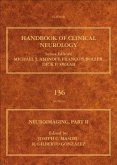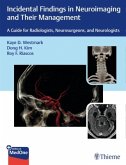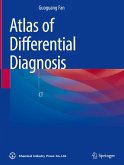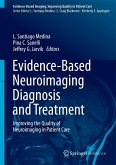Neuroimaging, Part One, a text from The Handbook of Clinical Neurology illustrates how neuroimaging is rapidly expanding its reach and applications in clinical neurology. It is an ideal resource for anyone interested in the study of the nervous system, and is useful to both beginners in various related fields and to specialists who want to update or refresh their knowledge base on neuroimaging.
This first volume specifically covers a description of imaging techniques used in the adult brain, aiming to bring a comprehensive view of the field of neuroimaging to a varying audience. It brings broad coverage of the topic using many color images to illustrate key points.
Contributions from leading global experts are collated, providing the broadest view of neuroimaging as it currently stands. For a number of neurological disorders, imaging is not only critical for diagnosis, but also for monitoring the effect of therapies, and the entire field is moving from curing diseases to preventing them. Most of the information contained in this volume reflects the newness of this approach, pointing to this new horizon in the study of neurological disorders.
This first volume specifically covers a description of imaging techniques used in the adult brain, aiming to bring a comprehensive view of the field of neuroimaging to a varying audience. It brings broad coverage of the topic using many color images to illustrate key points.
Contributions from leading global experts are collated, providing the broadest view of neuroimaging as it currently stands. For a number of neurological disorders, imaging is not only critical for diagnosis, but also for monitoring the effect of therapies, and the entire field is moving from curing diseases to preventing them. Most of the information contained in this volume reflects the newness of this approach, pointing to this new horizon in the study of neurological disorders.
"Parts 1 and 2 of this handbook provide a comprehensive collection of concise chapters covering nearly all areas of neuroradiology, written by recognized leaders in the field." --World Neurosurgery
Parts 1 and 2 of this handbook provide a comprehensive collection of concise chapters covering nearly all areas of neuroradiology, written by recognized leaders in the field. Each chapter contains up-to-date information, with well-chosen references for further study. Despite the diversity of topics, the organization is logical, starting with imaging methods and followed by pathology and common indications for brain and spine imaging, as well as pediatric neuroimaging. Chapters on neurointervention and high-resolution postmortem imaging contribute to the distinctive nature of this collection.
Section I focuses on the wide range of neuroimaging techniques, including myelography, an important topic that is often neglected in the age of magnetic resonance imaging (MRI) of spine disorders. These sections provide excellent background for physicians in all fields of neuroscience, as well as useful review for radiologists and radiology trainees. Both technical and practical information is provided. Hot topics, such as dual-energy computed tomography (CT), as well as established techniques like MR perfusion, are described, and useful examples and illustrative images are provided. The section also includes chapters describing nuclear medicine examinations, such as positron emission tomography and single-photon emission CT, which are now an integral part of the workup of neurodegenerative disorders.
The next 3 sections review diseases of the brain, spine, and peripheral nervous system. Magnetic resonance neurography, a relatively new technique, is given excellent coverage. MRI and ultrasound of skeletal muscle are reviewed, a novel addition to a neuroradiology text, given that these are studies typically interpreted by musculoskeletal radiologists.
Sections V and VI are a strength of this text, describing the proper imaging evaluation of common neurologic syndromes and approach to the differential diagnosis of common imaging findings. The authors provide recommendations and clear rationales for choosing the appropriate imaging examination based on patient history and symptoms. In the differential diagnosis chapters, the reader is taught to interpret imaging findings like a radiologist, an exercise that should prove valuable and interesting to all specialists who personally evaluate imaging studies.
Section VII provides an overview of the most common pediatric pathologies. Three chapters are dedicated to cerebral vascular intervention, covering the primary indications for these techniques: endovascular treatment of stroke, aneurysm, and arteriovenous malformations. Treatment options and succinct summaries of clinical trials are valuable additions. The final chapter is unique, detailing the role of postmortem imaging in validating MRI properties with direct histopathological correlation.
This creative collection should prove interesting and valuable to a wide range of practitioners and students who wish to increase their knowledge of neuroscience and the broad choice of neuroimaging tools available to study the human nervous system, spine, skull base, and head and neck.
~ Wende N. Gibbs, MD, MS, Department of Radiology, University of Southern California, Los Angeles, California, USA
Parts 1 and 2 of this handbook provide a comprehensive collection of concise chapters covering nearly all areas of neuroradiology, written by recognized leaders in the field. Each chapter contains up-to-date information, with well-chosen references for further study. Despite the diversity of topics, the organization is logical, starting with imaging methods and followed by pathology and common indications for brain and spine imaging, as well as pediatric neuroimaging. Chapters on neurointervention and high-resolution postmortem imaging contribute to the distinctive nature of this collection.
Section I focuses on the wide range of neuroimaging techniques, including myelography, an important topic that is often neglected in the age of magnetic resonance imaging (MRI) of spine disorders. These sections provide excellent background for physicians in all fields of neuroscience, as well as useful review for radiologists and radiology trainees. Both technical and practical information is provided. Hot topics, such as dual-energy computed tomography (CT), as well as established techniques like MR perfusion, are described, and useful examples and illustrative images are provided. The section also includes chapters describing nuclear medicine examinations, such as positron emission tomography and single-photon emission CT, which are now an integral part of the workup of neurodegenerative disorders.
The next 3 sections review diseases of the brain, spine, and peripheral nervous system. Magnetic resonance neurography, a relatively new technique, is given excellent coverage. MRI and ultrasound of skeletal muscle are reviewed, a novel addition to a neuroradiology text, given that these are studies typically interpreted by musculoskeletal radiologists.
Sections V and VI are a strength of this text, describing the proper imaging evaluation of common neurologic syndromes and approach to the differential diagnosis of common imaging findings. The authors provide recommendations and clear rationales for choosing the appropriate imaging examination based on patient history and symptoms. In the differential diagnosis chapters, the reader is taught to interpret imaging findings like a radiologist, an exercise that should prove valuable and interesting to all specialists who personally evaluate imaging studies.
Section VII provides an overview of the most common pediatric pathologies. Three chapters are dedicated to cerebral vascular intervention, covering the primary indications for these techniques: endovascular treatment of stroke, aneurysm, and arteriovenous malformations. Treatment options and succinct summaries of clinical trials are valuable additions. The final chapter is unique, detailing the role of postmortem imaging in validating MRI properties with direct histopathological correlation.
This creative collection should prove interesting and valuable to a wide range of practitioners and students who wish to increase their knowledge of neuroscience and the broad choice of neuroimaging tools available to study the human nervous system, spine, skull base, and head and neck.
~ Wende N. Gibbs, MD, MS, Department of Radiology, University of Southern California, Los Angeles, California, USA








